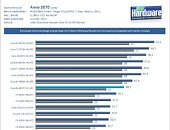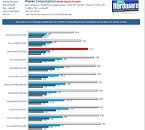Sunday, July 7th 2013

Intel Haswell 35W Dual-Core i5-4570T Benchmarks Surface Online
While Intel's quad-core Haswell architecture based 4th generation Core processors are already out there dominating benchmark charts (even if only by a small margin) and scoring new accolades in power efficiency, the dual-core Core processors have been left in the dark. At least, in the desktop segment. Not anymore though, as PC Games Hardware managed to score a sample of the energy efficient Core i5-4570T, a dual-core Haswell based processor for the desktop with a very impressive, and low, 35W TDP only.
Here's a quick look at the Haswell desktop processors line-up:While the Haswell desktop SKU in question is an energy efficient dual-core part, it doesn't fall short of delivering satisfactory performance. It manages to edge competing solutions from AMD, with more number of cores and many factors higher TDP, in some of the benchies. Check out a couple of them, posted below for your viewing pleasure.For the complete benchmark results, hit the source link posted below.
Source:
PC Games Hardware
Here's a quick look at the Haswell desktop processors line-up:While the Haswell desktop SKU in question is an energy efficient dual-core part, it doesn't fall short of delivering satisfactory performance. It manages to edge competing solutions from AMD, with more number of cores and many factors higher TDP, in some of the benchies. Check out a couple of them, posted below for your viewing pleasure.For the complete benchmark results, hit the source link posted below.




39 Comments on Intel Haswell 35W Dual-Core i5-4570T Benchmarks Surface Online
Yeah, these results are totally unbiased and relevant to current gaming use for these chips.
outside of battlefield 3, there are maybe 1 or 2 games that run better on amd than intel. the motherboard doesn't have much of an effect on that. fx chips are just slower. welcome to reality.
Intel limits the chipsets you can use if you want to overclock so by default they get better boards. Everyone knows AMD is going to lose so no one bothers about getting a high end board especially for a mid or low end chip. The top end chips tend to get nice boards so meh.
I really don't see someone buying a 990fx board for an amd FX4xxx.
And plenty of people do exact that. the diff. in price for a 990FX board and a decent 970 is only about $25. Future proofing as well as planning for future upgrade.No. My point was they are comparing a chip being tested on a top-end board even though it is at default settings. While the AMD counterparts are being tested, as stated above with a handicap. High-end boards from Intel limit overclocking options and differ in features. AMD boards actually differ in performance a 400 MT/s performance difference is huge since that applies too all board communications between the processor and the RAM and Northbridge.
And in reality, when comparing modern games the diff. between AMD and Intel is often minor or non-existent. FX chips are slower overall, but Vishera has proven to hold its in multi-threaded tests.
In the end, I am not trying to say FX chips are better than Intel. I am saying these results are bias and should not be given much weight.
Real Interesting when I change the test game on that site the results tell a different story:
i5 are called i5's instead of i3's even if they have the same core count is a strategy from mobile use. In mobile, i5's are only differentiated mainly by having turbo boost enabled. I guess they are slowly bringing that naming convention over to desktop. In mobile there are 2c/4t i7's. Not saying that this is right but this is what I think they are basing their decisions on. Sort of like the i5 7xx vs i5 6xx. The difference in i5 was not only the change in core count but also the process was different. This is going to be a problem since intel judges their chips differently desktop vs mobile based on realtive performance of the platform to name the chips rather than based on core-count.
basically
-single cores, low end dual cores are celeron
-higher end dual cores are pentium
-dual cores with hyper-threading are core i3
-all quad cores without hyper-threading and any dual cores with turbo boost are core i5
-all quad cores with hyper-threading are core i7 (with one exception, the dual core mobile i7, which is clocked at or over 3 ghz during typical load and has an extra MB of l3 cache).
edit- i accidentally a word.